Although I still teach a lot of classes at Black Wing Shooting Center in Delaware, Ohio, my role has evolved to include planning and administration of our training programs, as well as executing those plans. Consequently, I have become more interested in things such as instructor development and the standardization of procedures and techniques.
Among other things, we teach defensive use of the firearm, and while we recognize that a violent criminal assault is a fluid, chaotic event that often demands improvisation, that improvisation has to be born of some sensible, practiced technique.
And from what I have observed, reloading a revolver during a fight is among the most difficult, least likely to succeed tasks during an emergency. So despite my built-in suspicion of controlling the movements of others to a fine degree, here is as straightforward a practice technique as I can present. As described, this is intended for a right-handed shooter. Of course southpaws can run revolvers, but they are stacking the deck against themselves to a pretty unreasonable degree.
We start with the recognition that the gun needs to be reloaded. Bring the gun in close to your body — your retention position. Note that in the interests of clarity, the pictures do not depict the gun up close. The right thumb operates the cylinder release latch. At the same time, the left hand wraps under and around the revolver, so that the middle and ring fingers of the left hand can push the cylinder open from the right side of the frame.
As the cylinder opens, the right hand passes control of the gun to the left. The idea is that the dominant hand (with its greater dexterity) is now free to perform the upcoming tasks.
The left hand pivots the gun upward, which allows the maximum opportunity for gravity to assist the removal of the spent cartridge cases from the cylinder. The right hand reaches over and operates the ejector rod. While training, do not find and push the rod with just a fingertip. Degradation of fine motor dexterity and lessened sensitivity may make locating the tip of the ejector rod difficult. Instead, use the palm of the hand so that positive contact is assured.
With the cylinder now empty, the left hand rotates the gun to point generally downward, again allowing gravity to contribute to inserting the fresh cartridges. The right hand is at this time retrieving the live ammunition, which should be in the form of a speed loader or speed strip.
Most people tend to place the spare ammunition on the non-dominant side of their body. This works fine with semi-automatic pistols because the level of dexterity needed to perform the reload is available from the non-dominant hand. However, reloading the revolver requires more precise control, so it is best done by the dominant hand. This means that spare ammo for the revolver needs to be within easy reach of the dominant hand — the opposite of what most of us want to do.
With the revolver oriented downward, the right hand inserts the cartridges into the cylinder, freeing them from the loading device. The now-empty device has served its purpose and is dropped or discarded at once. This frees the right hand to take control of the revolver again. The right hand takes the grip and the left hand pushes the cylinder up into the closed and locked position. The left hand can now resume its place in a proper two-handed grip.
With practice, the above technique can be performed quickly and smoothly. It can even be applied to left-handed users, at least conceptually. The key ingredient is to allow the dominant hand the ability to perform the more precise or complicated tasks. This means briefly passing the gun into the non-dominant hand and back again.
Other ways to teach revolver reloads exist. My purpose here is to share what is in my opinion a good method, so that it can be a well from which a successful improvisation might spring. God forbid any of us should need it!
Share tips, start a discussion or ask one of our experts or other students a question.
Already a member? Sign in
41 Responses to “Reloading a Revolver”
Premium Membership
Unlock exclusive member content from our industry experts.
- 24/7 Access to Premium Personal Defense and Firearm Training Videos and Drills
- Step-by-Step Instructional Demos and Guides
- 50% Off Video Downloads Purchased in the Personal Defense Network Shop
- Access to Ask the Expert Program
Unlock exclusive member content from our industry experts.
- 24/7 Access to Premium Personal Defense and Firearm Training Videos and Drills
- Step-by-Step Instructional Demos and Guides
- 2 Full-Length Video Downloads to Watch Offline
- 50% Off Video Downloads Purchased in the Personal Defense Network Shop
- Access to Ask the Expert Program
Gold Membership
$340 Value
Get everything included in Premium plus exclusive Gold Membership benefits.
- 24/7 Access to Premium Personal Defense and Firearm Training Videos and Drills
- Step-by-Step Instructional Demos and Guides
- 9 Full-Length Video Downloads to Watch Offline
- 2 Full-Length Personal Defense Classes to Keep for Life
- 2 In-Depth Skill Development Presentations
- Discounts on Purchase-to-Own Content in the Personal Defense Network Shop
- Access to Ask the Expert Program
- Exclusive GOLD LIVE Streaming Events
Sign in to Personal Defense Network
Enter your sign in info below

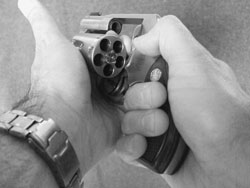
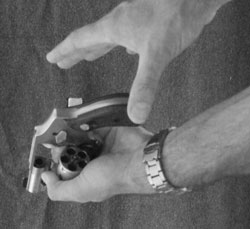

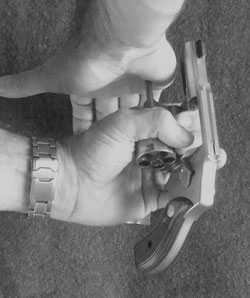
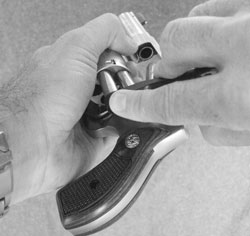
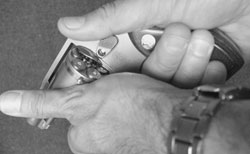
I have been practicing the Massad Ayoob method. Here's an old video of his. What's wrong with his method?
My advice. Don't swap the gun to the support hand. You risk dropping it in a high stress situation. Maybe your hands are sweaty due to stress or bloody as a result of an injury. Instead, keep the gun in you shooting hand, release the cylinder using your thumb, insert reload(s) singly or with a speed loader, close the cylinder with your support hand/palm and come back up on target. You can use your shooting hand index finger to keep the cylinder open and prevent it from partially closing during the reload. When I started in law enforcement everyone was still using revolvers. I was a newbie and adopted this method to reload my trusty .357 Ruger Security Six. It worked then and still does.
I wonder how many people you've killed with this Bad presentation. A revolver should Never leave the safety of the shooting hand.
I use a Govenor and as was taught to also make it a practice to turn barrel counter clockwise. Do you know why or does it matter?
The example in the picture is of a small five shot revolver. There is an important difference to be aware of here as compared to a full-size revolver. (I am familiar with the S&W J-Frames, others may be different) Step five mentions using a speed loader or speed strip, two completely different things. What is important to know is that the ejector on five shot j-frame revolvers by design does not have a long enough stroke to fully eject the spent casings. A sharp whack may eject them but there's no guarantee, especially if firing hot +p loads or if the cylinder has dirty chambers. This makes use of a speed loader difficult at best. The purpose of the short stroke ejector on the j-frame was so one could shoot a couple rounds, duck behind cover, swing the cylinder open and, with the muzzle pointed downward, push the ejector rod. Release the rod and the live rounds slide back into the chamber while the expanded spent casings remain protruding from the cylinder. Use the fingers of your dominant hand to pick them out, discard and refill with a "speed strip." Fun times at the range, not so fun if one is being shot at!! BTW, I believe Bianchi is credited with coining the name, "Speed Strip."
My difficulty is rotating the empty gun downward, can't seem to twist my wrist far enough unless I lower my left arm.
Your method obviously can work, but I prefer a quicker method that involves fewer movements. I prefer to push the cylinder release with my right thumb as I push the cylinder open and hold it open with my right index finger. Before I open the cylinder, I use my left hand to retrieve my Safariland speedloader and hold it between my left index finger and left thumb. I point the muzzle up and I place my left palm to operate the ejector rod as soon as the cylinder swings open. I place my right thumb to the right of the hammer to clear space for ejected cases to fall free. I operate the ejector rod one time, then point the muzzle down to insert the rounds from the speedloader into the chambers. I use Safariland speedloaders so I can just shove the speedloader to chamber the new rounds without having to change my grip on the speedloader or turn any knob. Then I let the empty speedloader fall away and close the cylinder with the heel of my left hand as I again level my gun at my adversary. Throughout the process I retain the shooting grip on the revolver. Notice that the revolver never leaves my shooting hand, and I bring my hands together only one time. If an adversary can see what I'm doing, he or she probably won't have a clue that I am in the process of reloading until I have my muzzle pointed up and the empty cases are falling out; from then the adversary will have very little time to react before I have lowered my muzzle, chambered new rounds and leveled my gun again. This is a pretty simple revolver reloading method that with practice can become quite smooth. Smooth is fast.
What about a single action revolver? What is the fastest way of unloading and reloading? Thanks for the information on double action revolvers.
Interesting article with good information, but it misses a key point. If a person is going to carry a wheel gun, I started at 16 with a S&W 19 and now carry a S&W 625, I feel that they need to practice loading with both the dominant hand an the non dominant hand. In any self defense situation there is always the chance of injury or some other reason that a person might not be able to do a standard reload. Our police chief, who okayed my carrying, stressed this important fact over and over to me and the officers. So I always teach them how to do one handed loading, off hand loading, and awkward position loading of their wheel gun. I love my 1911, but I can't carry it because it is to valuable, 1917 make and issue, so I went back to my first love, the .45 Colt, and try to teach people all the things I have learned since 1977. With practice my students seem to feel comfortable carrying a wheel gun now.
both of my hands work well. use a speed loader or use full moon clips. thank you for your tips. best of the day to you, bob hobbs